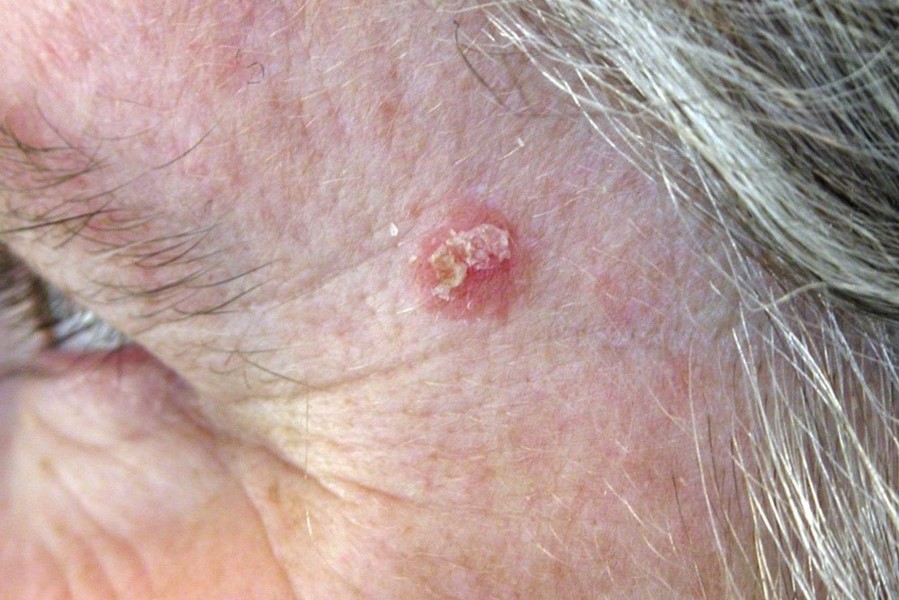
How to recognise actinic keratosis
Red or whitish spots that tend to flake and cause itching? It could be actinic keratosis
This is a proliferation of atypical, i.e. not normal, keratinocytes in an area of the skin that has been constantly exposed to UV radiation (sun, sunlamps), resulting in chronic skin damage.
Actinic keratoses were traditionally classified as precancerous lesions, although they are nowadays considered to be in-situ tumours
In recent years, dermatological prevention has played an increasingly important role.
Melanoma is the main target, but it is not the only skin cancer to be feared.
The most frequent skin tumours in the population are non-melanoma skin cancers.
These are skin cancers that are not strictly associated with a degeneration of the cells that produce melanin (melanocytes), but of keratinocytes, which are by far the most abundant cells in our epidermis.
What actinic keratosis looks like
Actinic keratoses take the form of red (erythematous), white or yellowish patches with an often dry and flaky surface.
Sometimes they may appear as reddish-brownish patches until they become true yellowish-white or dark crusts.
They are often easier to feel than to see due to their rough surface.
Where actinic keratoses form
Actinic keratoses typically occur in photo-exposed areas, i.e. those most prone to sunlight exposure: face, head, neck, back of the hands.
Actinic keratoses: risk factors
On the one hand, risk factors may be represented by the individual’s characteristics such as advanced age, fair skin, genetic features, immunosuppression by drugs and others.
On the other hand, the presence of exogenous factors such as continuous and cumulative exposure to UV radiation, exposure to toxic substances such as arsenic and tar.
The symptoms
In most cases actinic keratoses are asymptomatic, although some patients report symptoms such as burning, pain, itching and rarely bleeding.
As already mentioned, they appear mainly on the areas most exposed to sunlight: head, face, ears, nose, lips, neck, cleavage, forearms, backs of hands, etc.
What to do in case of suspected actinic keratosis
The first thing to do is to undergo a dermatological examination, in order to have a definite diagnosis and to be able to set up the most suitable therapy for each individual case.
Treatment
There are different therapeutic approaches, which have to be evaluated case by case. Actinic keratoses can be treated by:
- direct therapy of the lesions, such as cryotherapy with liquid nitrogen;
- laser therapy
- surgery.
In some cases it is advisable to treat the entire area at risk of developing keratoses, (field of erasure) to avoid the progression of the pathology over larger areas.
In the latter case, specific pharmacological treatments and/or photodynamic therapy (PDT) may be used.
How to prevent actinic keratosis
The best way to prevent actinic keratoses is to
- avoid exposure to the sun during the hottest hours, especially at certain latitudes;
- use protective clothing and sun creams with a very high protection factor. There are currently photoprotectors on the market specifically formulated to prevent the onset of actinic keratoses;
- eating a diet rich in antioxidant foods;
- using specific supplements to prevent sun damage.
Is actinic keratosis dangerous?
Fortunately, actinic keratosis is a lesion considered to be ‘locally malignant’, i.e. capable of creating damage only in the area where it occurs.
If not properly treated, however, it can give rise to squamous cell carcinomas, which can become invasive and, in particular areas of the face and head, can invade the bone tissue to the underlying tissues.
Rarely, squamous cell carcinomas can metastasize, resulting in multi-organ invasion and possible death.
In the light of these facts, it is clear that a preventive approach is of paramount importance to avoid degeneration of actinic keratoses, preventing them from developing into full-blown skin cancers.
Read Also:
Emergency Live Even More…Live: Download The New Free App Of Your Newspaper For IOS And Android
Rare Diseases, Ebstein Anomaly: A Rare Congenital Heart Disease
Autoimmune Diseases: The Sand In The Eyes Of Sjögren’s Syndrome


